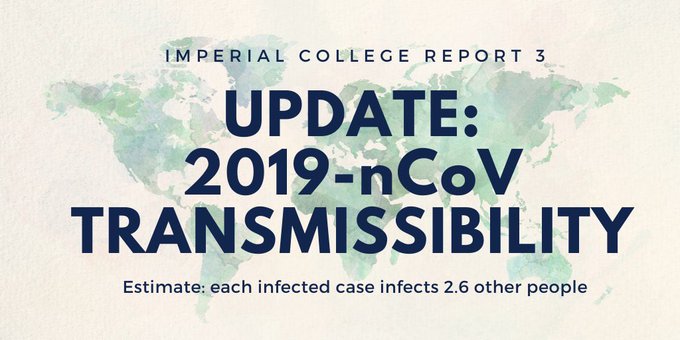Scientists
Estimate 44,000 Virus
Cases, Doubling Every 6 Days
Mish
The University of Minnesota Center for Infectious Disease Research and Policy (CIDRAP) reports nCoV spread in China's cities could trigger global epidemic.
At a media briefing in Hong Kong today, experts from the University of Hong Kong (HKU) estimated that the number of cases in Wuhan as of Jan 25 was dramatically higher than the country's official totals and may be as high as 44,000. They also estimated that the city's cases will double over the next 6 days.Lisa Gralinski, PhD, a coronavirus researchers at the University of North Carolina at Chapel Hill, noted on Twitter last night that the 2019-nCoV total has already topped that of MERS-CoV, which at nearly 2,500 cases since 2012 continues to sicken people, mostly in Saudi Arabia.
Real-Time Nowcast
CIDRAP linked to this Real-time nowcast and forecast on the extent of the Wuhan CoV outbreak by Professors Gabriel Leung and Joseph Wu of the LKS Faculty of Medicine at the University of Hong Kong.
The featured chart is from the above link. Here is another one.
Too Late for Wuhan Quarantine
Global Epidemic Points From the Hong Kong Report
- 2019-nCoV may be about to become a global epidemic
- Self-sustaining human-to-human spread is already present in all major Chinese cities
- Seeding outside mainland China and subsequent local establishment may become inevitable, unless some or all of the following interventions are deployed quickly:
- Substantial, draconian measures limiting population mobility taken immediately
- Cancellation of mass gatherings
- School closures
- Instituting work-from-home arrangements
Dr. Eric Feigl-Ding Comments
UPDATE: Transmission of #coronoavirus estimated at 2.6 by another research group (lower than the 3.8 initial reports). But 2.6 is still extremely bad —each infected person will infect 2.6 others. Even the authors admit #CoronaOutbreak containment will be very difficult. Thread:
3,200 people are talking about this
CDC Too Late, and Way Behind the Curve
10) BREAKING from @CDCgov: Escalating really fast - now the US CDC and State Dept now recommending all Americans to avoid travel to China — yes, the *entire country* of China— because of #coronoavirus. Wow. wwwnc.cdc.gov/travel/notices…
1. Too damn late.
2. Anyone with an ounce of sense cancelled their flights to China already.
3. Countries need to ban all flights from China whether China does so or not
CDC and WHO both hopelessly behind the curve!
See Mike "Mish" Shedlock's other Tweets
Ma Xiaowei, director of China’s National Health Commission, said #coronavirus has incubation period of 10 to 14 days, during which virus can be contagious but patients don’t display symptoms. That marks a major difference between this coronavirus and SARS. scmp.com/news/china/soc…
1,099 people are talking about this
Higher Pandemic Risk than SARS
The Cold Spring Harbor Laboratory comments on the Transmission dynamics of 2019 novel coronavirus (2019-nCoV)
As of January 23, 2020, a total of 830 confirmed 2019-nCoV cases were identified across China, and 9 cases were reported overseas. The average incubation duration of 2019-nCoV infection was 4.8days. The average period from onset of symptoms to isolation of 2019-nCoV and SARS cases were 2.9 and 4.2 days, respectively. The R values of 2019-nCoV were 2.90 (95%CI: 2.32-3.63) and 2.92 (95%CI: 2.28-3.67) estimated using EG and ML respectively, while the corresponding R values of SARS-CoV were 1.77 (95%CI: 1.37-2.27) and 1.85 (95%CI: 1.32-2.49). We observe a decreasing trend of the period from onset to isolation and R values of both 2019-nCoV and SARS-CoV. Interpretation: The 2019-nCoV may have a higher pandemic risk than SARS broken out in 2003. The implemented public-health efforts have significantly decreased the pandemic risk of 2019-nCoV. However, more rigorous control and prevention strategies and measures to contain its further spread.
The authors say "This article is a preprint and has not been certified by peer review."
Self-sustaining human-to-human transmission of the novel coronavirus (2019-nCov) is the only plausible explanation of the scale of the outbreak in Wuhan. We estimate that, on average, each case infected 2.6 (uncertainty range: 1.5-3.5) other people up to 18th January 2020, based on an analysis combining our past estimates of the size of the outbreak in Wuhan with computational modelling of potential epidemic trajectories. This implies that control measures need to block well over 60% of transmission to be effective in controlling the outbreak.Illustration of estimation method for central estimate of R0=2.6. Red curve represents median cumulative case numbers over time, calculated from 5000 simulated trajectories of the epidemic, assuming zoonotic exposure of 40 cases in December 2019 and the generation time and variability in infectiousness of SARS. The grey region indicates the 95 percentile range of trajectories – individual simulated epidemics (a random subset of which are shown as light grey curves) are highly variable, reflecting the random nature of disease transmission. Dotted lines indicate January 18th (vertical) and 4000 cumulative cases (horizontal).
The above discussion and chart from Transmissibility of 2019-nCoV by MRC Centre for Global Infectious Disease Analysis, J-IDEA, Imperial College London, UK.
106 Admitted Deaths
China coronavirus death toll climbs to 106 as confirmed cases surpass 4,000 | South China Morning Post scmp.com/news/china/soc…
32 people are talking about this
100% guaranteed to be drastically understated. Many reported cases already labeled as pneumonia.
British Quarantine Underway
Coronavirus: British nationals returning from Wuhan to be quarantined for two weeks forexlive.com/news/!/coronav…
See ForexLive's other Tweets
A Word About Trust
Nobody trusts Chinese economic data but everybody is now relying on their healthcare data...
the medical field is going to learn this the hard way, the same way the finance community has had to
364 people are talking about this
Meanwhile, please note Hundreds of Virus Carrying Planes Headed for US, London, Paris, Vancouver.
Mike "Mish" Shedlock


















Thank you for the most valuable information....You must have done good research for the work, I appreciate your efforts. Coronavirus
ReplyDelete